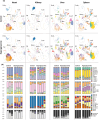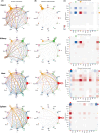Multi-organ single-cell RNA sequencing in mice reveals early hyperglycemia responses that converge on fibroblast dysregulation
- PMID: 38305779
- PMCID: PMC12014014
- DOI: 10.1096/fj.202302003R
Multi-organ single-cell RNA sequencing in mice reveals early hyperglycemia responses that converge on fibroblast dysregulation
Abstract
Diabetes causes a range of complications that can affect multiple organs. Hyperglycemia is an important driver of diabetes-associated complications, mediated by biological processes such as dysfunction of endothelial cells, fibrosis, and alterations in leukocyte number and function. Here, we dissected the transcriptional response of key cell types to hyperglycemia across multiple tissues using single-cell RNA sequencing (scRNA-seq) and identified conserved, as well as organ-specific, changes associated with diabetes complications. By studying an early time point of diabetes, we focus on biological processes involved in the initiation of the disease, before the later organ-specific manifestations had supervened. We used a mouse model of type 1 diabetes and performed scRNA-seq on cells isolated from the heart, kidney, liver, and spleen of streptozotocin-treated and control male mice after 8 weeks and assessed differences in cell abundance, gene expression, pathway activation, and cell signaling across organs and within organs. In response to hyperglycemia, endothelial cells, macrophages, and monocytes displayed organ-specific transcriptional responses, whereas fibroblasts showed similar responses across organs, exhibiting altered metabolic gene expression and increased myeloid-like fibroblasts. Furthermore, we found evidence of endothelial dysfunction in the kidney, and of endothelial-to-mesenchymal transition in streptozotocin-treated mouse organs. In summary, our study represents the first single-cell and multi-organ analysis of early dysfunction in type 1 diabetes-associated hyperglycemia, and our large-scale dataset (comprising 67 611 cells) will serve as a starting point, reference atlas, and resource for further investigating the events leading to early diabetic disease.
Keywords: RRID:IMSR_JAX:000664; RRID:SCR_001618; RRID:SCR_001905; RRID:SCR_007322; RRID:SCR_019010; RRID:SCR_021946; RRID:SCR_022146; RRID:SCR_022254; endothelial cells; fibrosis; gene expression; hyperglycemia; mice; monocytes; myofibroblast; single-cell RNA-seq; streptozotocin; type 1 diabetes.
© 2024 The Authors. The FASEB Journal published by Wiley Periodicals LLC on behalf of Federation of American Societies for Experimental Biology.
Figures






References
Publication types
MeSH terms
Substances
Grants and funding
LinkOut - more resources
Full Text Sources
Medical
Molecular Biology Databases

